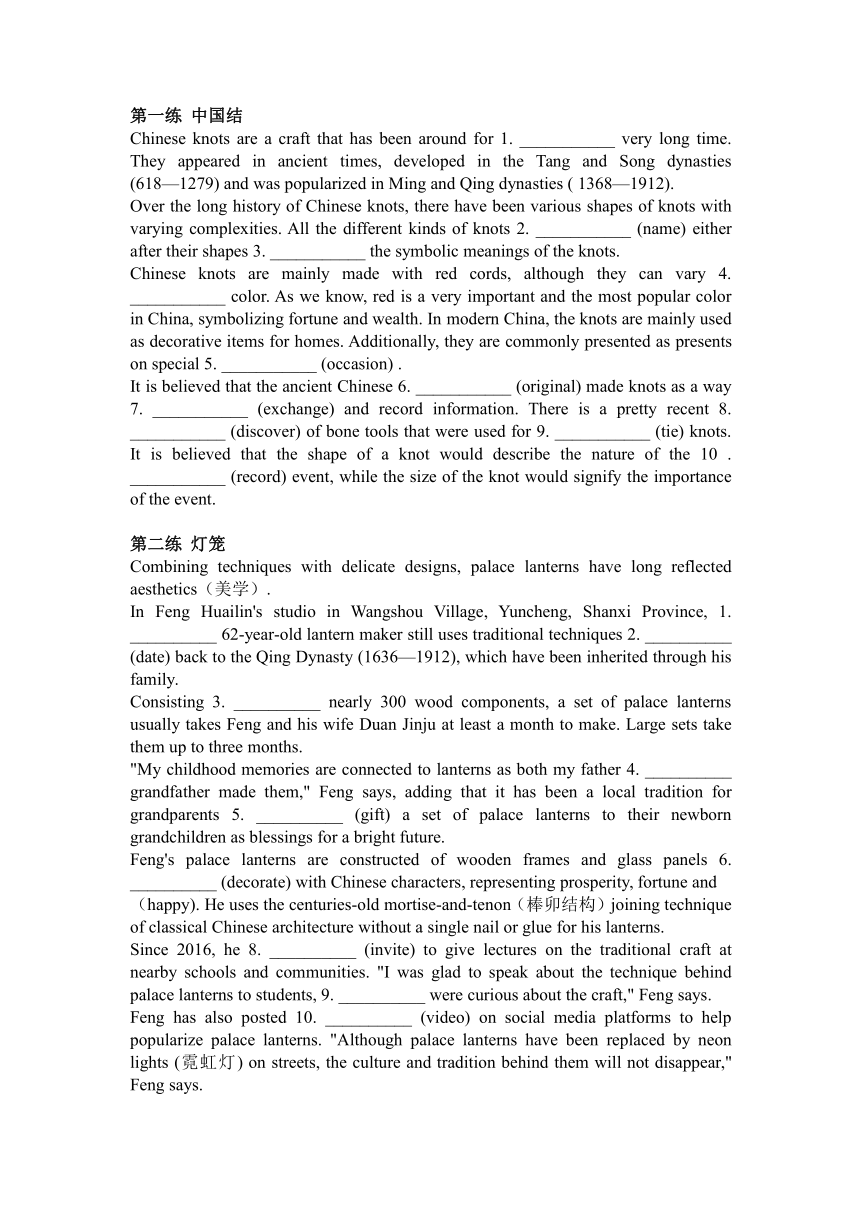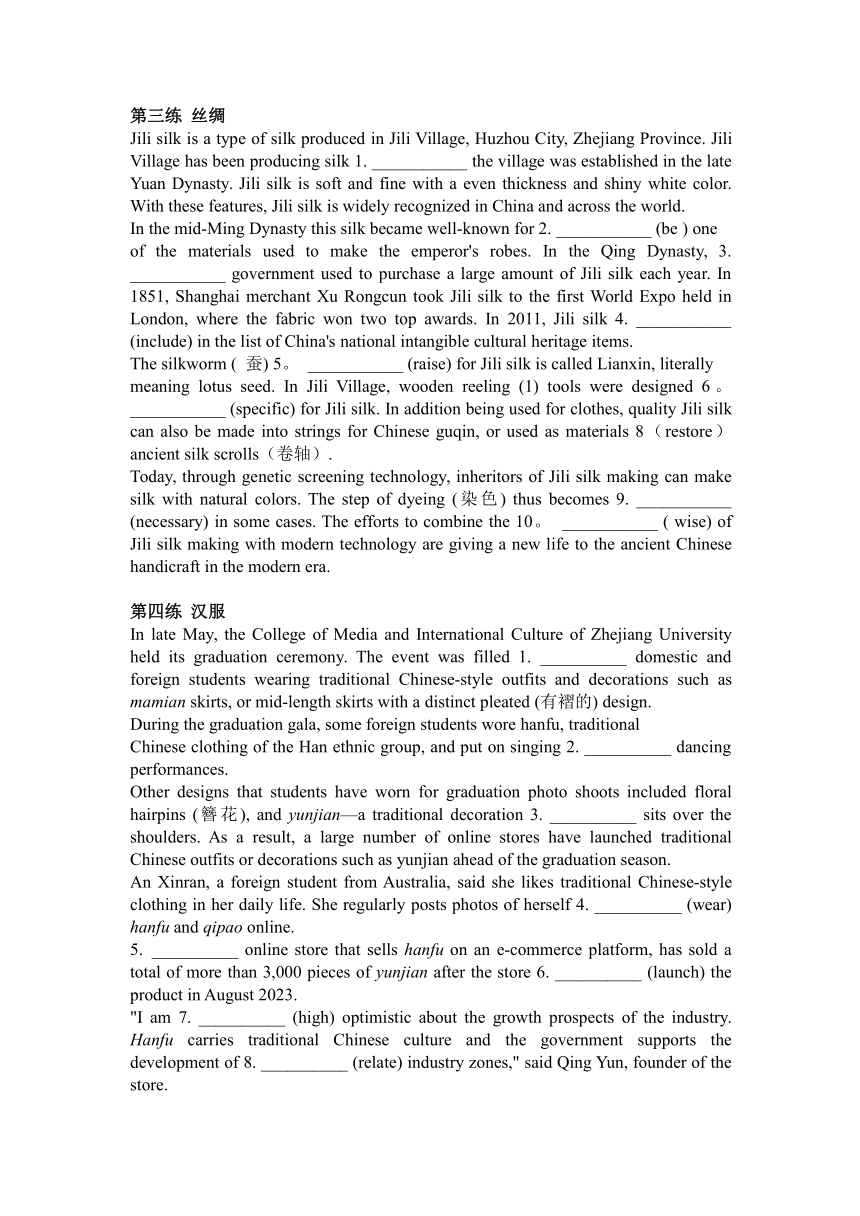2025届高三英语二轮复习语法填空传统文化之艺术国粹 第四期(含解析)
文档属性
| 名称 | 2025届高三英语二轮复习语法填空传统文化之艺术国粹 第四期(含解析) |  | |
| 格式 | docx | ||
| 文件大小 | 26.6KB | ||
| 资源类型 | 教案 | ||
| 版本资源 | 人教版(2019) | ||
| 科目 | 英语 | ||
| 更新时间 | 2025-03-05 13:24:05 | ||
图片预览



文档简介
第一练 中国结
Chinese knots are a craft that has been around for 1. ___________ very long time. They appeared in ancient times, developed in the Tang and Song dynasties (618—1279) and was popularized in Ming and Qing dynasties ( 1368—1912).
Over the long history of Chinese knots, there have been various shapes of knots with varying complexities. All the different kinds of knots 2. ___________ (name) either after their shapes 3. ___________ the symbolic meanings of the knots.
Chinese knots are mainly made with red cords, although they can vary 4. ___________ color. As we know, red is a very important and the most popular color in China, symbolizing fortune and wealth. In modern China, the knots are mainly used as decorative items for homes. Additionally, they are commonly presented as presents on special 5. ___________ (occasion) .
It is believed that the ancient Chinese 6. ___________ (original) made knots as a way 7. ___________ (exchange) and record information. There is a pretty recent 8. ___________ (discover) of bone tools that were used for 9. ___________ (tie) knots. It is believed that the shape of a knot would describe the nature of the 10 . ___________ (record) event, while the size of the knot would signify the importance of the event.
第二练 灯笼
Combining techniques with delicate designs, palace lanterns have long reflected aesthetics(美学).
In Feng Huailin's studio in Wangshou Village, Yuncheng, Shanxi Province, 1. __________ 62-year-old lantern maker still uses traditional techniques 2. __________ (date) back to the Qing Dynasty (1636—1912), which have been inherited through his family.
Consisting 3. __________ nearly 300 wood components, a set of palace lanterns usually takes Feng and his wife Duan Jinju at least a month to make. Large sets take them up to three months.
"My childhood memories are connected to lanterns as both my father 4. __________ grandfather made them," Feng says, adding that it has been a local tradition for grandparents 5. __________ (gift) a set of palace lanterns to their newborn grandchildren as blessings for a bright future.
Feng's palace lanterns are constructed of wooden frames and glass panels 6. __________ (decorate) with Chinese characters, representing prosperity, fortune and
(happy). He uses the centuries-old mortise-and-tenon(棒卯结构)joining technique of classical Chinese architecture without a single nail or glue for his lanterns.
Since 2016, he 8. __________ (invite) to give lectures on the traditional craft at nearby schools and communities. "I was glad to speak about the technique behind palace lanterns to students, 9. __________ were curious about the craft," Feng says.
Feng has also posted 10. __________ (video) on social media platforms to help popularize palace lanterns. "Although palace lanterns have been replaced by neon lights (霓虹灯) on streets, the culture and tradition behind them will not disappear," Feng says.
第三练 丝绸
Jili silk is a type of silk produced in Jili Village, Huzhou City, Zhejiang Province. Jili Village has been producing silk 1. ___________ the village was established in the late Yuan Dynasty. Jili silk is soft and fine with a even thickness and shiny white color. With these features, Jili silk is widely recognized in China and across the world.
In the mid-Ming Dynasty this silk became well-known for 2. ___________ (be ) one
of the materials used to make the emperor's robes. In the Qing Dynasty, 3. ___________ government used to purchase a large amount of Jili silk each year. In 1851, Shanghai merchant Xu Rongcun took Jili silk to the first World Expo held in London, where the fabric won two top awards. In 2011, Jili silk 4. ___________ (include) in the list of China's national intangible cultural heritage items.
The silkworm ( 蚕) 5。 ___________ (raise) for Jili silk is called Lianxin, literally
meaning lotus seed. In Jili Village, wooden reeling (1) tools were designed 6。 ___________ (specific) for Jili silk. In addition being used for clothes, quality Jili silk can also be made into strings for Chinese guqin, or used as materials 8(restore)ancient silk scrolls(卷轴).
Today, through genetic screening technology, inheritors of Jili silk making can make silk with natural colors. The step of dyeing (染色) thus becomes 9. ___________ (necessary) in some cases. The efforts to combine the 10。 ___________ ( wise) of Jili silk making with modern technology are giving a new life to the ancient Chinese handicraft in the modern era.
第四练 汉服
In late May, the College of Media and International Culture of Zhejiang University held its graduation ceremony. The event was filled 1. __________ domestic and foreign students wearing traditional Chinese-style outfits and decorations such as mamian skirts, or mid-length skirts with a distinct pleated (有褶的) design.
During the graduation gala, some foreign students wore hanfu, traditional
Chinese clothing of the Han ethnic group, and put on singing 2. __________ dancing performances.
Other designs that students have worn for graduation photo shoots included floral hairpins (簪花), and yunjian—a traditional decoration 3. __________ sits over the shoulders. As a result, a large number of online stores have launched traditional Chinese outfits or decorations such as yunjian ahead of the graduation season.
An Xinran, a foreign student from Australia, said she likes traditional Chinese-style clothing in her daily life. She regularly posts photos of herself 4. __________ (wear) hanfu and qipao online.
__________ online store that sells hanfu on an e-commerce platform, has sold a total of more than 3,000 pieces of yunjian after the store 6. __________ (launch) the product in August 2023.
"I am 7. __________ (high) optimistic about the growth prospects of the industry. Hanfu carries traditional Chinese culture and the government supports the development of 8. __________ (relate) industry zones," said Qing Yun, founder of the store.
The main customer group is aged between 18 and 25, and they are mainly young female consumers who like traditional Chinese attire (服装). Most 9. __________ (order) come from major cities that boast cultural relics and sightseeing spots which are 10. __________ (suit) for wearing hanfu, Qing said.
第一练
【语篇解读】本文是一篇说明文,介绍了中国结的历史、命名颜色和用途。
【答案解析】
1.a 考査冠词。for along time 意为“很长一段时间”,为固定表达,故用不定冠词 a。
2.are named 考查动词时态语态。讲述客观事实用一般现在时,复数主语 All the different kinds of knots 和 name 之间为被动关系,故填are named。
3.or 考查连词。either..or...意为“要么……要么……”,为固定结构。
4.in 考查介词。vary in sth.为固定用法,意为“(大小、形状等)相异”。此处指“中国结可以在颜色方面相异”用介词 in。
5.occasions 考查名词复数。occasion意为“特殊场合;重大活动;盛会”时为可数名词,此处有复数含义,故填名词复数。
6.originally 考查副词。作状语,修饰动词made,意为“最初”,用副词 originally。
7.to exchange 考查非谓语动词。a way to do sth.意为“做某事的方法”,为固定用法。
8.discovery 考查词性转换。由空前的a可知,此处应用名词,意为“发现”,故填 discovery。
9.tying 考查非谓语动词。做介词for的宾语,用动词-ing形式。
10.recorded 考查非谓语动词。event和record之间为逻辑上的被动关系,表“被记录的”,故填过去分词作定语。
第二练
【语篇解读】本文是一篇新闻报道,介绍了山西运城市王守村的宫灯制作大师冯怀林。
【答案解析】
1.the 考查冠词。此处特指上文提到的Feng Huailin,用定冠词 the 修饰。
考查非谓语动词。
2.dating 考查非谓语动词。traditional techniques和date back to之间为逻辑上的主动关系,故用动词-ing形式作后置定语。
3.of 考查介词。Consist of意为“由……组成”,为固定表达。
4.and 考查连词。both... and..意为“……和……都”为固定表达。
5.to gift 考查非谓语动词。it is a tradition for sb. to do sth意为“某人做某事是一种传统”,为固定用法。
6.decorated 考查非谓语动词。Glass panels和decorate之间为逻辑上的被动关系,故用过去分词作后置定语。
7.happiness 考查词性转换。空处和prosperity,fortune并列作representing的宾语,意为“快乐;幸福”,故填名词happiness。
8.has been invited 考查动词时态语态和主谓一致。由中时间状语Since 2016可知,空处应用现在完成时,且主语he 为第三人称单数,与动词 invite 之间为被动关系,故填has been invited。
9.who 考查定语从关系代词。此处为一个非限制性定语从句,先行词 students指人,关系词代替先行词在从句中作主语,故用关系代词who引导。
10.videos 考查名词复数。video作“视频”讲为可数名词此处有复数含义,故用名词复数。
第三练
【语篇解读】本文是一篇说明文,介绍了产自浙江省湖州市辑里村的辑里丝
【答案解析】
1.since 考查连词。句意:自元朝末年建村以来,辑里村就一直在生产丝绸。根据句意可知,“1thevillage was established in the late Yuan Dynasty”是时间状语从句,主谓语 has been producing 使用了现在完成进行时态,从句是主句动作的起点,应用连词since 引导该从句,意为“自从……以来”,故填连词since。
2. being考查非谓语动词。句意:在明朝中期,这种丝绸作为制作龙袍的材料之一而闻名。作介词for 的宾语,应用动词-ing 形式,故填 being。
3.the 考查冠词。此处特指上文提到的the Qing Dynasty时期的政府,故用定冠词the 修饰。
4. was included 考查动词时态语态和主谓一致。句意:2011年,辑里丝被列入国家级非物质文化遗产名录。根据时间状语In2011可知,此处讲述过去的事情,应用一般过去时,又因单数主语Jili silk与include 之间是被动关系,应用被动语态,故填was included。
5. raised 考查非谓语动词。句意:为生产辑里丝而养的蚕被称为莲心,字面意思是莲子。动词raise与主语The silkworm为逻辑上的被动关系,故用过去分词作后置定语。
6.specifically 考查副词。作状语,修饰动词,应用副词,意为“特意;专门地”,故填 specifically。
7.to 考查介词。in addition to意为“除…以外还”,是固定短语。
8.to restore 考查非谓语动词。句意:除了用于服装,优质的辑里丝还可以制作中国古琴的琴弦,或用作修复古代丝卷轴的材料。作后置定语,修饰materials,说明这些材料的用途,故填动词不定式 to restore。
9 . unnecessary 考查形容词。句意:通过基因选技术,制辑里丝的继承人能够制作出具有自然颜色的丝绸,因此在某些情况下,染色的步骤变得不必要。结合句意可知,此处作表语,应用形容词,意为“不必要的”,故填unnecessary。
wisdom 考查名词。句意:制辑里丝的智慧与现代技术相结合的努力赋予了中国古代手工艺在现代的新生命。作动词 combine 的宾语,且被the 修饰,用名词,意为“智慧”,故填 wisdom。
第四练
【语篇解读】本文是一篇新闻报道,报道了浙江大学毕业季国内外学生穿戴传统中式服饰的“国风”热【答案解析】
with 考查介词。be filled with...意为“充满……”是固定用法。
and 考查连词。句意:在毕业晚会上,一些外国学生身着汉服,即汉族的传统服装,并进行了歌舞表演。根据句意可知,singing 与dancing是并列关系,故填并列连词and。
that/which 考查定语从句关系代词。本句为限制性定语从句,先行词 a traditional decoration指物,关系词代替先行词在从句中作主语,故填关系代词that或which来引导定语从句。
考查非谓语动词。herself与动词wear之间为逻4.wearing辑上的主动关系,故填动词-ing 形式作后置定语。
An 考查冠词。store 意为“商店”时是可数名词,此处指“一家网店”,且online首字母发元音音素,故用不定冠词an 修饰。
launched 考查动词时态。根据时间状语in August 2023可知,此处讲述过去发生的事情,应用一般过去时,故填launched
highly 考查副词。作状语,修饰形容词optimistic,表“很:非常”,应用副词,故填highly。注意high作副词时意为“在高处:(价值、数量)大;音调高”。
related 考查形容词。作定语,修饰名词zones,应用形容词,意为“相关的”故填related。
orders 考查名词复数。order意为“订单”,是可数名词在句中被Most修饰,有复数含义,故填orders。
suitable 考查形容词。作表语,应用形容词,表“合适的”,故填 suitable。
Chinese knots are a craft that has been around for 1. ___________ very long time. They appeared in ancient times, developed in the Tang and Song dynasties (618—1279) and was popularized in Ming and Qing dynasties ( 1368—1912).
Over the long history of Chinese knots, there have been various shapes of knots with varying complexities. All the different kinds of knots 2. ___________ (name) either after their shapes 3. ___________ the symbolic meanings of the knots.
Chinese knots are mainly made with red cords, although they can vary 4. ___________ color. As we know, red is a very important and the most popular color in China, symbolizing fortune and wealth. In modern China, the knots are mainly used as decorative items for homes. Additionally, they are commonly presented as presents on special 5. ___________ (occasion) .
It is believed that the ancient Chinese 6. ___________ (original) made knots as a way 7. ___________ (exchange) and record information. There is a pretty recent 8. ___________ (discover) of bone tools that were used for 9. ___________ (tie) knots. It is believed that the shape of a knot would describe the nature of the 10 . ___________ (record) event, while the size of the knot would signify the importance of the event.
第二练 灯笼
Combining techniques with delicate designs, palace lanterns have long reflected aesthetics(美学).
In Feng Huailin's studio in Wangshou Village, Yuncheng, Shanxi Province, 1. __________ 62-year-old lantern maker still uses traditional techniques 2. __________ (date) back to the Qing Dynasty (1636—1912), which have been inherited through his family.
Consisting 3. __________ nearly 300 wood components, a set of palace lanterns usually takes Feng and his wife Duan Jinju at least a month to make. Large sets take them up to three months.
"My childhood memories are connected to lanterns as both my father 4. __________ grandfather made them," Feng says, adding that it has been a local tradition for grandparents 5. __________ (gift) a set of palace lanterns to their newborn grandchildren as blessings for a bright future.
Feng's palace lanterns are constructed of wooden frames and glass panels 6. __________ (decorate) with Chinese characters, representing prosperity, fortune and
(happy). He uses the centuries-old mortise-and-tenon(棒卯结构)joining technique of classical Chinese architecture without a single nail or glue for his lanterns.
Since 2016, he 8. __________ (invite) to give lectures on the traditional craft at nearby schools and communities. "I was glad to speak about the technique behind palace lanterns to students, 9. __________ were curious about the craft," Feng says.
Feng has also posted 10. __________ (video) on social media platforms to help popularize palace lanterns. "Although palace lanterns have been replaced by neon lights (霓虹灯) on streets, the culture and tradition behind them will not disappear," Feng says.
第三练 丝绸
Jili silk is a type of silk produced in Jili Village, Huzhou City, Zhejiang Province. Jili Village has been producing silk 1. ___________ the village was established in the late Yuan Dynasty. Jili silk is soft and fine with a even thickness and shiny white color. With these features, Jili silk is widely recognized in China and across the world.
In the mid-Ming Dynasty this silk became well-known for 2. ___________ (be ) one
of the materials used to make the emperor's robes. In the Qing Dynasty, 3. ___________ government used to purchase a large amount of Jili silk each year. In 1851, Shanghai merchant Xu Rongcun took Jili silk to the first World Expo held in London, where the fabric won two top awards. In 2011, Jili silk 4. ___________ (include) in the list of China's national intangible cultural heritage items.
The silkworm ( 蚕) 5。 ___________ (raise) for Jili silk is called Lianxin, literally
meaning lotus seed. In Jili Village, wooden reeling (1) tools were designed 6。 ___________ (specific) for Jili silk. In addition being used for clothes, quality Jili silk can also be made into strings for Chinese guqin, or used as materials 8(restore)ancient silk scrolls(卷轴).
Today, through genetic screening technology, inheritors of Jili silk making can make silk with natural colors. The step of dyeing (染色) thus becomes 9. ___________ (necessary) in some cases. The efforts to combine the 10。 ___________ ( wise) of Jili silk making with modern technology are giving a new life to the ancient Chinese handicraft in the modern era.
第四练 汉服
In late May, the College of Media and International Culture of Zhejiang University held its graduation ceremony. The event was filled 1. __________ domestic and foreign students wearing traditional Chinese-style outfits and decorations such as mamian skirts, or mid-length skirts with a distinct pleated (有褶的) design.
During the graduation gala, some foreign students wore hanfu, traditional
Chinese clothing of the Han ethnic group, and put on singing 2. __________ dancing performances.
Other designs that students have worn for graduation photo shoots included floral hairpins (簪花), and yunjian—a traditional decoration 3. __________ sits over the shoulders. As a result, a large number of online stores have launched traditional Chinese outfits or decorations such as yunjian ahead of the graduation season.
An Xinran, a foreign student from Australia, said she likes traditional Chinese-style clothing in her daily life. She regularly posts photos of herself 4. __________ (wear) hanfu and qipao online.
__________ online store that sells hanfu on an e-commerce platform, has sold a total of more than 3,000 pieces of yunjian after the store 6. __________ (launch) the product in August 2023.
"I am 7. __________ (high) optimistic about the growth prospects of the industry. Hanfu carries traditional Chinese culture and the government supports the development of 8. __________ (relate) industry zones," said Qing Yun, founder of the store.
The main customer group is aged between 18 and 25, and they are mainly young female consumers who like traditional Chinese attire (服装). Most 9. __________ (order) come from major cities that boast cultural relics and sightseeing spots which are 10. __________ (suit) for wearing hanfu, Qing said.
第一练
【语篇解读】本文是一篇说明文,介绍了中国结的历史、命名颜色和用途。
【答案解析】
1.a 考査冠词。for along time 意为“很长一段时间”,为固定表达,故用不定冠词 a。
2.are named 考查动词时态语态。讲述客观事实用一般现在时,复数主语 All the different kinds of knots 和 name 之间为被动关系,故填are named。
3.or 考查连词。either..or...意为“要么……要么……”,为固定结构。
4.in 考查介词。vary in sth.为固定用法,意为“(大小、形状等)相异”。此处指“中国结可以在颜色方面相异”用介词 in。
5.occasions 考查名词复数。occasion意为“特殊场合;重大活动;盛会”时为可数名词,此处有复数含义,故填名词复数。
6.originally 考查副词。作状语,修饰动词made,意为“最初”,用副词 originally。
7.to exchange 考查非谓语动词。a way to do sth.意为“做某事的方法”,为固定用法。
8.discovery 考查词性转换。由空前的a可知,此处应用名词,意为“发现”,故填 discovery。
9.tying 考查非谓语动词。做介词for的宾语,用动词-ing形式。
10.recorded 考查非谓语动词。event和record之间为逻辑上的被动关系,表“被记录的”,故填过去分词作定语。
第二练
【语篇解读】本文是一篇新闻报道,介绍了山西运城市王守村的宫灯制作大师冯怀林。
【答案解析】
1.the 考查冠词。此处特指上文提到的Feng Huailin,用定冠词 the 修饰。
考查非谓语动词。
2.dating 考查非谓语动词。traditional techniques和date back to之间为逻辑上的主动关系,故用动词-ing形式作后置定语。
3.of 考查介词。Consist of意为“由……组成”,为固定表达。
4.and 考查连词。both... and..意为“……和……都”为固定表达。
5.to gift 考查非谓语动词。it is a tradition for sb. to do sth意为“某人做某事是一种传统”,为固定用法。
6.decorated 考查非谓语动词。Glass panels和decorate之间为逻辑上的被动关系,故用过去分词作后置定语。
7.happiness 考查词性转换。空处和prosperity,fortune并列作representing的宾语,意为“快乐;幸福”,故填名词happiness。
8.has been invited 考查动词时态语态和主谓一致。由中时间状语Since 2016可知,空处应用现在完成时,且主语he 为第三人称单数,与动词 invite 之间为被动关系,故填has been invited。
9.who 考查定语从关系代词。此处为一个非限制性定语从句,先行词 students指人,关系词代替先行词在从句中作主语,故用关系代词who引导。
10.videos 考查名词复数。video作“视频”讲为可数名词此处有复数含义,故用名词复数。
第三练
【语篇解读】本文是一篇说明文,介绍了产自浙江省湖州市辑里村的辑里丝
【答案解析】
1.since 考查连词。句意:自元朝末年建村以来,辑里村就一直在生产丝绸。根据句意可知,“1thevillage was established in the late Yuan Dynasty”是时间状语从句,主谓语 has been producing 使用了现在完成进行时态,从句是主句动作的起点,应用连词since 引导该从句,意为“自从……以来”,故填连词since。
2. being考查非谓语动词。句意:在明朝中期,这种丝绸作为制作龙袍的材料之一而闻名。作介词for 的宾语,应用动词-ing 形式,故填 being。
3.the 考查冠词。此处特指上文提到的the Qing Dynasty时期的政府,故用定冠词the 修饰。
4. was included 考查动词时态语态和主谓一致。句意:2011年,辑里丝被列入国家级非物质文化遗产名录。根据时间状语In2011可知,此处讲述过去的事情,应用一般过去时,又因单数主语Jili silk与include 之间是被动关系,应用被动语态,故填was included。
5. raised 考查非谓语动词。句意:为生产辑里丝而养的蚕被称为莲心,字面意思是莲子。动词raise与主语The silkworm为逻辑上的被动关系,故用过去分词作后置定语。
6.specifically 考查副词。作状语,修饰动词,应用副词,意为“特意;专门地”,故填 specifically。
7.to 考查介词。in addition to意为“除…以外还”,是固定短语。
8.to restore 考查非谓语动词。句意:除了用于服装,优质的辑里丝还可以制作中国古琴的琴弦,或用作修复古代丝卷轴的材料。作后置定语,修饰materials,说明这些材料的用途,故填动词不定式 to restore。
9 . unnecessary 考查形容词。句意:通过基因选技术,制辑里丝的继承人能够制作出具有自然颜色的丝绸,因此在某些情况下,染色的步骤变得不必要。结合句意可知,此处作表语,应用形容词,意为“不必要的”,故填unnecessary。
wisdom 考查名词。句意:制辑里丝的智慧与现代技术相结合的努力赋予了中国古代手工艺在现代的新生命。作动词 combine 的宾语,且被the 修饰,用名词,意为“智慧”,故填 wisdom。
第四练
【语篇解读】本文是一篇新闻报道,报道了浙江大学毕业季国内外学生穿戴传统中式服饰的“国风”热【答案解析】
with 考查介词。be filled with...意为“充满……”是固定用法。
and 考查连词。句意:在毕业晚会上,一些外国学生身着汉服,即汉族的传统服装,并进行了歌舞表演。根据句意可知,singing 与dancing是并列关系,故填并列连词and。
that/which 考查定语从句关系代词。本句为限制性定语从句,先行词 a traditional decoration指物,关系词代替先行词在从句中作主语,故填关系代词that或which来引导定语从句。
考查非谓语动词。herself与动词wear之间为逻4.wearing辑上的主动关系,故填动词-ing 形式作后置定语。
An 考查冠词。store 意为“商店”时是可数名词,此处指“一家网店”,且online首字母发元音音素,故用不定冠词an 修饰。
launched 考查动词时态。根据时间状语in August 2023可知,此处讲述过去发生的事情,应用一般过去时,故填launched
highly 考查副词。作状语,修饰形容词optimistic,表“很:非常”,应用副词,故填highly。注意high作副词时意为“在高处:(价值、数量)大;音调高”。
related 考查形容词。作定语,修饰名词zones,应用形容词,意为“相关的”故填related。
orders 考查名词复数。order意为“订单”,是可数名词在句中被Most修饰,有复数含义,故填orders。
suitable 考查形容词。作表语,应用形容词,表“合适的”,故填 suitable。
